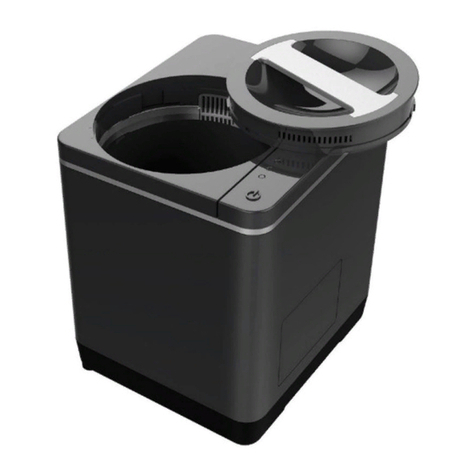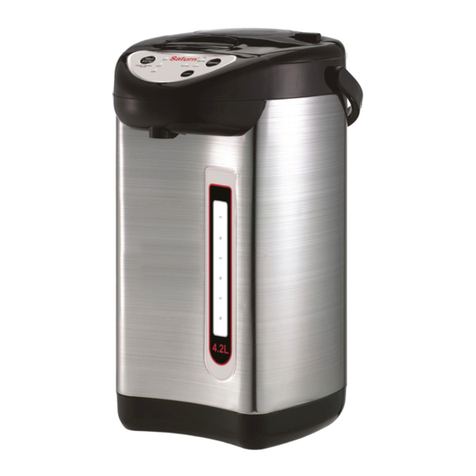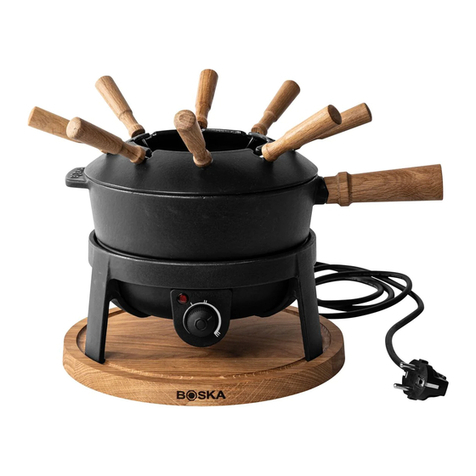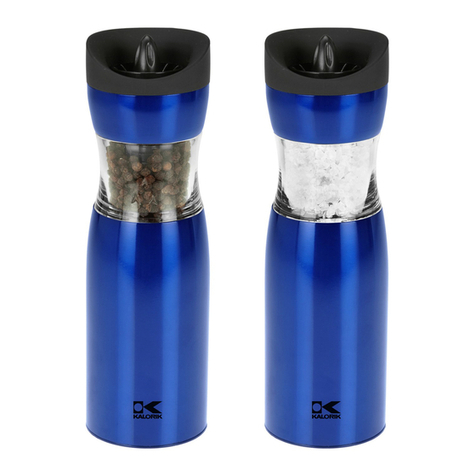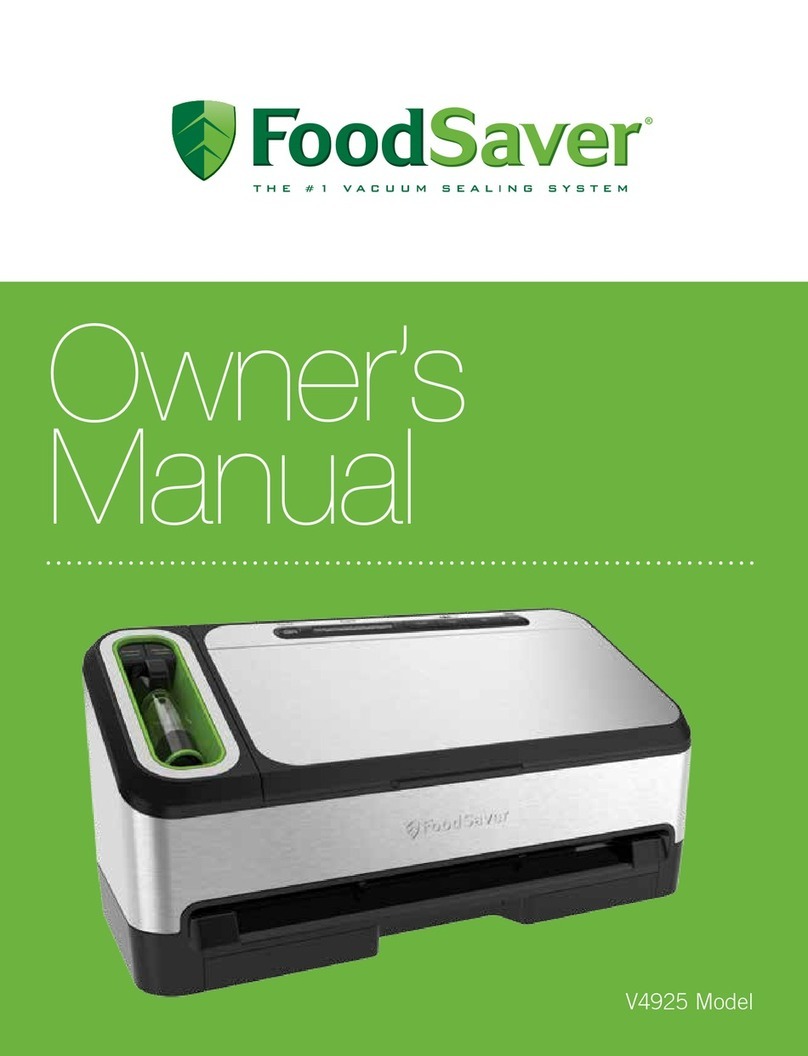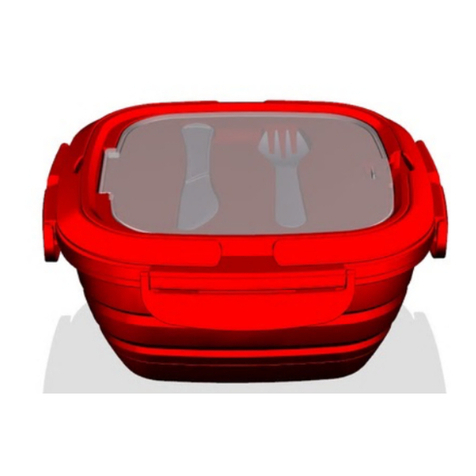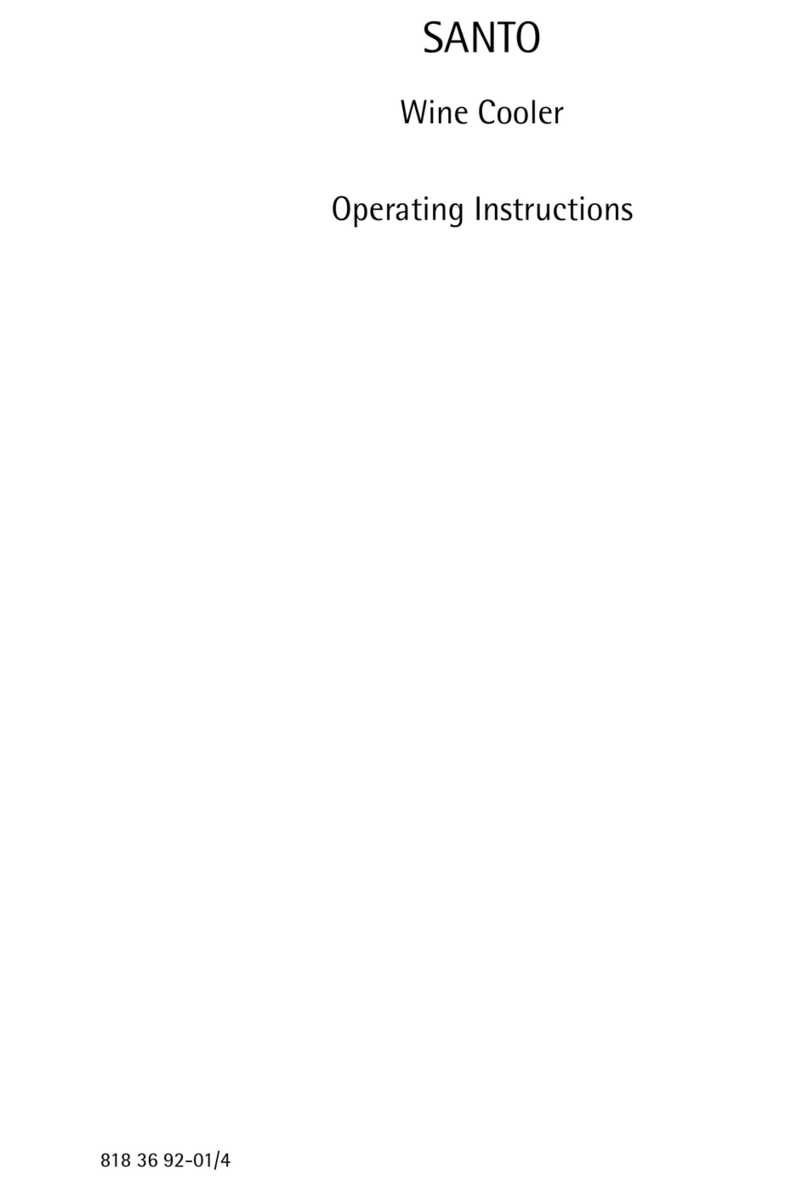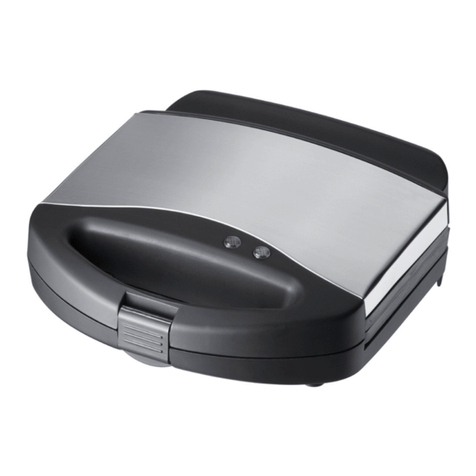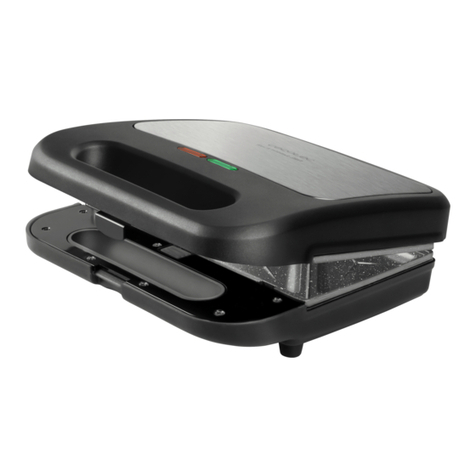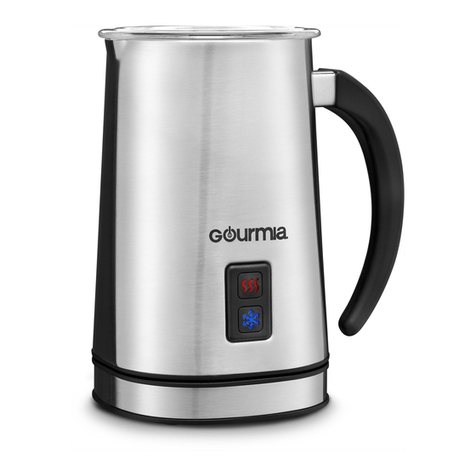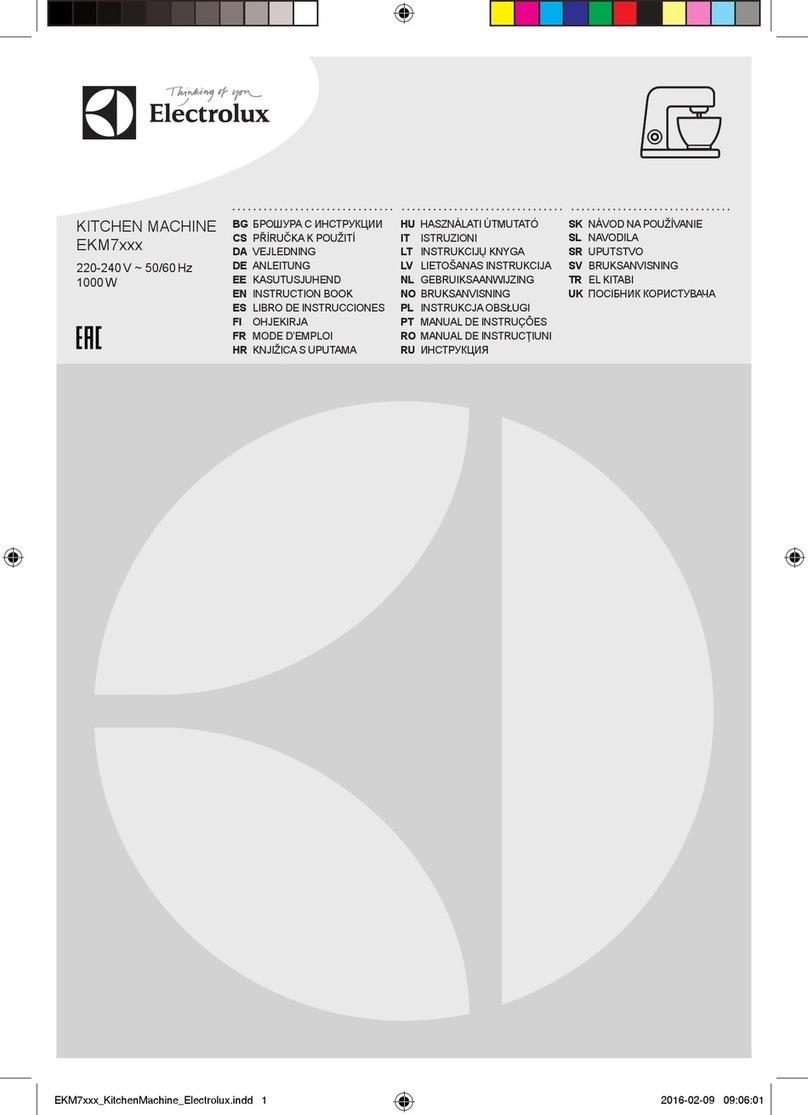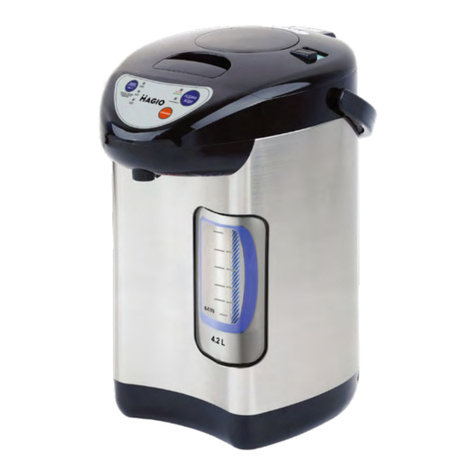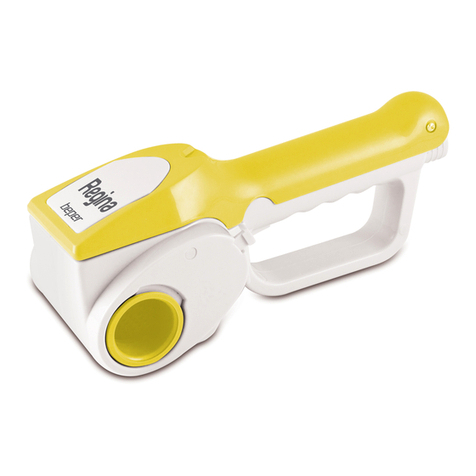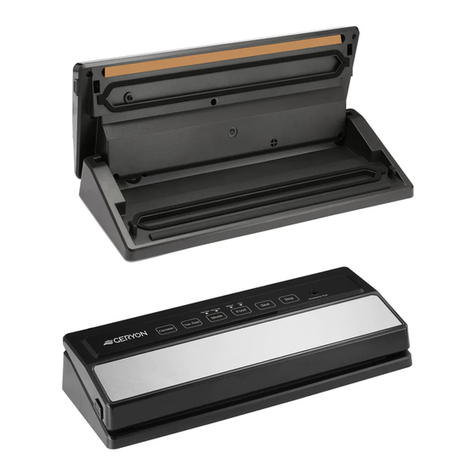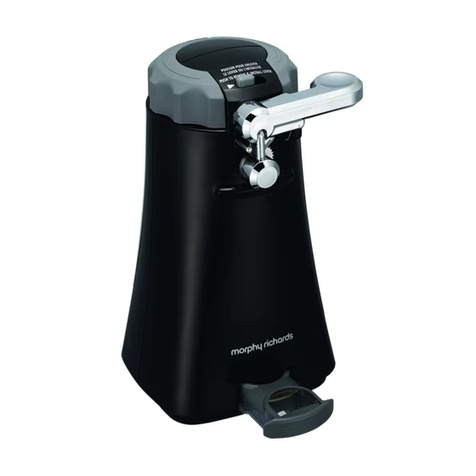FoodCycler MAESTRO FC-100 User manual


W E L C O M E T O T H E F U T U R E O F
F O O D W A S T E
The FoodCycler™ is an energy-efficient food recycler which transforms your leftovers and food
scraps into a nutrient-rich soil amendment. The aerobic process reduces food waste by up to
90%* of its original volume, leaving a garden-ready supplement that is scientifically proven to
nourish your garden.
This guide will familiarize you with your FoodCycler™, introduce you to its features and
functions, while also showing you how to use and care for your unit.
To ensure that you are using your unit safely and effectively, please read this guide thoroughly
prior to operating your new unit. Please be advised that this unit is designed for home and
office use only.
*Weight reduction is significantly dependent on the food (e.g.: coffee grinds will have little volume reduction).


C O N T E N T S
I M P O R T A N T S A F E G U A R D S
1
S P E C I F I C A T I O N S
2
P A R T S
3
G E T T I N G T O K N O W Y O U R F O O D C Y C L E R ™
4
U N I T S E T U P
5
R U N N I N G A C Y C L E
6
M A I N T A I N I N G Y O U R U N I T
7
R E P L A C I N G Y O U R C A R B O N F I L T E R S
8
R E P L A C I N G U N I T L I D F I L T E R
9
W H A T C A N B E C Y C L E D ?
10
U S I N G Y O U R B Y - P R O D U C T I N T H E G A R D E N
11
T H E F O O D C Y C L E R T I M E L I N E
12
F A Q
13
T R O U B L E S H O O T I N G
16

1
F O O D C Y C L E R ™
I M P O R T A N T S A F E G U A R D S
This appliance is intended for household use.
The FoodCycler™ is a Household Electric Appliances product.
Basic safety instructions should always be followed when handling electrical appliances. This includes the following:
Read all instructions in the manual.
This appliance is not intended for use by persons (including children) with reduced physical, sensory, or mental
capabilities, or lack of experience and knowledge, unless they are closely supervised and instructed
concerning use of the appliance by a person responsible for their safety. Close supervision is necessary when
any appliance is used by or near children. Children should be supervised to ensure that they do not play with
the appliance.
To avoid electrical shocks, keep cords, plugs and portable electrical appliances away from water and other
liquids.
Turn the unit off, then unplug the unit from outlet when not in use, prior to servicing and adding/removing
parts, and before cleaning the unit. To unplug the unit, grasp the plug and pull at the outlet. Never pull from
the power cord.
Allow unit to cool before assembling or disassembling parts and before cleaning the appliance.
Do not operate any appliance with a damaged cord or plug, a unit showing signs of malfunction, or any
product that has been dropped or damaged in any way.
The use of attachments not recommended or sold by the manufacturer may cause fire, electric shock, or injury.
Do not operate the machine outdoors
Do not operate at or store in below freezing temperatures.
Keep cord away from heat and sharp edges.
Unit must only be plugged into properly grounded outlets.
Do not touch any hot surfaces. Use the handles or knobs provided for safe handling.
Do not place the unit on or near a hot gas or electric burner.
Do not use appliance for any purpose other than its intended use.
Do not dismantle, reconfigure, alter or adapt the unit in any way.
Do not immerse the unit in water or liquids of any kind.
Keep the appliance and power cords out of reach of children.
Ensure that the surface of the unit is clear when closing the lid.
Do not tamper the electrical outlet at the rear of the unit.
Blades are sharp. Be cautious if/when reaching inside the removable Bucket.
Be cautious when handling the Bucket mid-cycle or immediately after cycling as the bucket may be hot.
Refrain from removing the bucket from the unit midcycle as the internal surfaces may be hot.
Keep fingers away from hinges to avoid pinching.
Avoid contacting moving parts. Do not attempt to defeat any safety interlock mechanisms
Notes on the Power Cord:
oa) A short power-supply cord (or short detachable power-supply cord) is provided to reduce the risks
resulting from becoming entangled in or tripping over a longer cord.
ob) Extension cords (or longer detachable power-supply cords) are available and may be used if care is
exercised in their use.
oc) If an extension cord (or a long detachable power-supply cord) is used:
▪1) The marked electrical rating of the detachable power-supply cord or extension cord should
greater than the electrical rating of the appliance;
▪2) If the appliance is of the grounded type, the extension cord should be a grounding type 3-
wire cord; and
▪3) The longer cord should be arranged so that it will not drape over the countertop or tabletop
where it can be tripped over, snagged, or pulled on unintentionally (especially by children).
SAVE THESE INSTRUCTIONS

F O O D C Y C L E R ™
S P E C I F I C A T I O N S
P R O D U C T N A M E
FoodCycler Maestro
M O D E L N U M B E R
FC-100/ FC-100E
P R O C E S S I N G M O D E ( S )
Drying, Grinding, Cooling
M A X W A T T A G E
500W
P O W E R I N P U T
FC-100
110-120V 60 Hz
FC-100E
220-240V 50/60Hz
E N E R G Y U S A G E
R U N N I N G
<1.5 kWh per cycle
S T A N D B Y
0.5 kWh per month
P R O C E S S I N G T I M E
4-9 hours
C A P A C I T Y
5.0L
W A S T E V O L U M E R E D U C T I O N
Up to 90%
W E I G H T ( O U T O F B O X )
29 lbs (13.1 kg)
D I M E N S I O N S ( O U T O F B O X )
(W) 13.5" x (D) 10.9" x (H) 13.8"
(W) 342 mm x (D) 276 mm x (H) 350 mm
2

F O O D C Y C L E R ™
P A R T S
1
2
3
4
5
6
Each one of these parts forms the complete FoodCycler™ system. Your FoodCycler™ will be
shipped with the waste Bucket, Carbon Filter and Bucket Lid in their correct placement inside
the unit.
1
FoodCycler™ Maestro Unit
2
Removable Bucket Lid with deodorizing Carbon Foam Liner (*pre-installed)
3
Refillable Carbon Filter
4
Carbon Refill Pack
5
Removable Bucket
6
Power cord
*Please Note: The Bucket handle is purposely offset to provide space for you to grip onto the
handle to pour out the by-product.
3

F O O D C Y C L E R ™
G E T T I N G T O K N O W Y O U R U N I T
P O W E R B U T T O N
Press once to start the cycle.
Open lid to pause cycle.
Press and hold for 3 seconds to turn the unit off.
Indicator solid: Unit running
Indicator breathing: Unit paused
L E D P R O G R E S S T R A C K
Cycle Indicator
C A R B O N F I L T E R R E P L A C E M E N T
I N D I C A T O R
Replace Carbon Filter Pellets (See page 8 for instructions on
how to replace the Carbon Pellets in your Filters.)
4

F O O D C Y C L E R ™
U N I T S E T U P
1.
2.
A)P R E P A R I N G Y O U R U N I T
1. Open unit lid.
2. Remove the Carbon Refill Pack and power cord from
Bucket.
B)P R E P A R I N G Y O U R R E F I L L A B L E
F I L T E R S
3.
4.
3. Remove the empty Refillable Carbon Filter Cartridge
from the unit.
4. Open the Refillable Carbon Filter Cartridge by
twisting the lid counter-clockwise.
5.
6.
5. Cut open the Carbon Pack, following the cut-line
guide along the top of the pack.
6. Empty the contents of the Refill Pack into the open
Refillable Carbon Filter Cartridge. (We recommend
doing this over a sink or towel, to avoid spillage).
7.
8.
7. Place the lid back on the Refillable Carbon Filter
Cartridge by aligning the notches on the cartridge
with the arrows on the lid. Twist the lid clockwise to
lock it in place. A slight click will indicate that the lid is
properly seated.
8. Slide the filled Refillable Carbon Filter back into the
unit cavity.
9.
10.
C) P L U G I N Y O U R U N I T
9. Close the unit lid, ensuring that the lid latch is in the
proper locked position.
11.
10. Insert the socket end of the power cord into the back
of the unit.
11. When ready to run a cycle, plug the three-pronged
plug into a wall outlet.
5

6
F O O D C Y C L E R ™
R U N N I N G A C Y C L E
1.
2.
1. Remove the Bucket from the unit.*
*While you can add food waste to your Bucket
while it is seated inside the FoodCycler™, we
recommend removing your Bucket from the
unit prior to adding food waste to the Bucket.
Food waste which falls outside of the Bucket
and into the unit may cause damage to internal
components.
2. Add food waste to the Bucket.*
*For a detailed list of the items which can be
processed by the FoodCycler™, see page 10.
3.
4.
3. When you are ready to run a cycle, insert the
Bucket into the unit, seating the bucket so that
it sits flush within the unit cavity. If the Bucket
does not seem to sit flush in the unit, twist the
Bucket slightly in small rotations of up to 60° in
each direction until it seats correctly.
*Remove internal Bucket stickers before
running a cycle. Remove Bucket Lid before
running a cycle.
4. Close the unit lid and lock it into place by
rotating the lid latch downwards
5.
6.
5. Plug the unit into an outlet if not already
plugged in.
6. Press the Power button once to start a cycle.
Once the cycle has begun, the LED Progress
Track will illuminate (blue).
Please Note: The cycle will last approximately
4-9 hours, depending on the amount of waste
and the moisture content of the food being
processed. Once complete, the unit will beep
once and shut itself off.

A D D I T I O N A L N O T E S O N R U N N I N G A C Y C L E
1. Always ensure that no food waste falls outside of the Bucket and into the unit. This may cause
damage to the motor and other internal components. We recommend removing the Bucket from the
unit prior to adding food waste to the Bucket. Keep your Bucket on your counter or kitchen table and
add food waste throughout the day/week until you are ready to start a cycle.
2. Do not overload your Bucket. The Bucket has a fill-line around the interior circumference of the
Bucket. Do not add food waste above this line. Do not press down on food waste within the Bucket.
Overloading the Bucket may cause the unit to jam.
3. If you would like to add more waste to your cycle while the unit is still running, you may pause the
cycle during Phase 1 to 3 by simply opening the lid. Adding food waste beyond Phase 3 will affect
the quality of the by-product. (See page 4 for instructions on using the unit's Pause feature.) You may
need to run another cycle to ensure the by-product is dry.
4. The unit will run more efficiently if the Bucket is filled up to the fill line rather than running it half-full.
5. The lid filter should be cleaned every 3 to 4 months or when the lid grille filter is blocked.
Periodically remove the lid grill filter and rinse under water to clean off dust. Dry the filter prior to
reinstalling. (See page 9)
6. Carbon filtration systems are not designed to change odors, rather they are used reduce the
intensity of odors. Processing particularly odorous foods may cause the unit to emit odors during
operation and may shorten the lifespan of the filter.
7. Processing particularly hard foods and excessively packing down food waste in the bucket may result
in increased noise levels during operation and reduce the longevity of the unit.
8. Processing overly moist foods may result in moist by-product. If the by-product is moist, we
recommend running another cycle to ensure a dry by-product.
9. The bucket may still be hot after running a cycle. We recommend waiting for the bucket to cool
before opening the lid and removing the bucket.
7
F O O D C Y C L E R ™
M A I N T A I N I N G Y O U R U N I T
To keep your FoodCycler™ clean, first ensure that the unit is unplugged. Then, using a damp,
wrung-out cloth, wipe down the outside surface of the unit, around the Bucket compartment of the
unit, and along the outside of the Bucket. Do not manually clean the inside of the Bucket as there are
sharp blades. Please refer to the Important Safeguards (see page 1) when cleaning your
FoodCycler™. Do not pour water or any liquids over the unit.
The bucket is intended to self-clean. Do not manually clean the inside of the Bucket. It is normal to
have by-product residue left over on the base of the Bucket and should not impact the unit’s ability
to cycle your food waste.
We do not recommend using any household cleaners when cleaning the unit.

8
F O O D C Y C L E R ™
R E P L A C I N G Y O U R C A R B O N F I L T E R
P E L L E T S
Replace the carbon pellets in your Carbon Filter when the Filter Change Indicator is illuminated (see
page 4 for details), or when you notice odors during cycling.
1.
2.
1. Open the unit lid by lifting the lid latch.
2. Remove the Refillable Carbon Filter Cartridge
from unit by pulling the tab.
3.
4.
3. Open the Refillable Carbon Filter Cartridge by
twisting the lid counter-clockwise.
4. Carbon pellets are safe to handle and entirely
biodegradable. Dispose of your used carbon
pellets according to local regulations.
5.
6.
5. Cut open your new Carbon Pack, following the
cut-line guide along the top of the pack.
6. Empty the contents of the pack into the open
Refillable Carbon Filter Cartridge. (*We
recommend doing this over a sink or towel, to
avoid spillage).
7.
8.
7. Place the lid back on the Refillable Carbon
Filter Cartridge by aligning the notches on the
cartridge with the arrows on the lid and
twisting clockwise. A slight click will indicate
that the lid is properly seated.
9.
10.
8. Slide the filled Refillable Carbon Filter
Cartridge into the unit cavity.
9. Close the unit lid.
10. Press and hold the Filter Change Indicator for
3 seconds or until the unit beeps to reset the
Filter Change reminder.

9
F O O D C Y C L E R ™
R E P L A C I N G U N I T L I D F I L T E R
The unit lid contains a lid filter, located behind the grille on the underside of the unit lid. This lid filter
should be cleaned every 3 to 4 months or when the lid grille filter is blocked.
1.
2.
1. Open the unit lid by lifting the lid latch.
2. Lift the lid grille from the retaining pin. If the lid
grille is dirty, you may clean it by wiping the
grille with a damp, wrung-out cloth.
3.
4.
3. Remove the lid filter situated behind the lid
grille.
4. Rinse lid filter with water or wipe clean with a
damp, wrung-out cloth
5.
6.
5. Insert the dry lid filter back into the lid cavity.
6. Add the lid grille onto the retaining pin and
press into place to ensure the lid grille is
properly seated. You will know the lid grille is
properly seated if it remains in place when the
unit lid is closed.

10
F O O D C Y C L E R ™
W H A T C A N B E C Y C L E D ?
Please Note: You will achieve ideal cycle results if your cycle contains a variety of food wastes.
YES
CUT UP PRIOR
IN SMALL AMOUNTS
NO
Most
vegetable &
fruit scraps
Beans, seeds
& legumes
Fibrous herbs
A small
amount of
paper
towel/tissue
Sauces,
dressings &
gravies
Pork & lamb
bones
Oils & fats
Beef bones
Poultry & fish
bones
Coffee grinds,
filters, tea
leaves &
teabags
Corn cobs &
husks
Pineapple
leaves
Starches
(bread, cake,
rice)
Hard pits (incl.
peach,
nectarine,
apricot, lychee
& mango)
Most
"compostable"
coffee pods
Eggs &
eggshells
Meat, tofu,
poultry & fish
Whole fruits
and
vegetables
Dairy products
Candy & gum
Shellfish (incl.
shells)
Avocado pits
Celery,
asparagus &
other fibrous
plants
Jellies & jams,
puddings
Cardboard

11
F O O D C Y C L E R ™
U S I N G Y O U R H O M E M A D E S O I L
A M E N D M E N T I N T H E G A R D E N
Using an intuitive cycle sensor, the FoodCycler™ pulverizes and aerates nearly all types of food
waste. Agitators quietly turn inside the Bucket, reducing food waste volume by up to 90%.
Simultaneously, the unit aerates and heats the Bucket contents, leaving only a small amount of
dry biomass.
While the by-product does not have the same microbial or bacterial qualities as traditional
compost, it is still rich in the important nutrients your garden soil requires to thrive. The by-
product is scientifically proven to be beneficial for optimal vegetation growth.
FoodCycler™ is a convenient, compact and energy efficient compost alternative. Traditional
compost, and composting alternatives (such as vermicompost systems, bokashi and compost
tumblers) can take weeks, if not months, to transform food waste into a garden-ready
supplement that is high in various micro and macro nutrients, as well as crucial organic
biomatter. Because of the intense aeration, heating and pulverization of the unit’s full cycle, this
process is accelerated to complete within 4 - 9 hours. Cycling also ensures that meat, dairy and
even some bones and processed foods can be added to the cycle. The level of heat emitted by
the unit during the cycle is sufficient to eliminate all bacteria and potential pathogens - even
weed seeds - allowing the by-product to be used safely and stored indefinitely. The resulting
biomass can also be used in the garden as a fertilizer or soil conditioner. See following page for
details on incorporating the by-product into your garden soil.

F O O D C Y C L E R ™
T H E F O O D C Y C L E R ™ T I M E L I N E
12

F O O D C Y C L E R ™
F A Q
1. Where should I store my unit?
The FoodCycler™ can be run in just about any area indoors that has a power outlet and sufficient space
(including basements and heated garages).
Ensure that the unit is sitting on a flat, dry surface.
Do not store the unit next to heaters and kitchen appliances which generate significant heat.
Do not store the FoodCycler™ outdoors, or in any place where it is likely to get wet or subjected to
below freezing temperatures.
Ensure the unit has adequate space surrounding the unit for proper ventilation. Do not block any vents
on the unit or place any objects on top of the lid during operation.
2. What can I process in the FoodCycler™?
Like any healthy diet, the FoodCycler™ performs best when fed a wide variety of foods. To ensure
optimal food waste breakdown, add multiple different types of food waste to every cycle, with heavier
foods interspersed with lighter, dryer foods. Avoid high concentrations of the following foods:
•starches (bread, cake, rice, pasta, mashed potatoes, stuffing)
•condiments, dressings, sauces & soups
•nut butters
•jam, jellies, marmalades
•high sugar fruits (grapes, cherries, melon, oranges, bananas, etc.)
The dense, starchy and/or moisture-rich composition of these foods make them difficult to process in
large quantities. For a complete guide on what you can and cannot process, please see page 10.
Prior to cycling, chop up items with a high fibre content, such as parsley and asparagus, as these items
can easily wrap around the Bucket's grinding arm and cause a jam.
If a jam occurs, the unit will stop processing and switch to self-protection mode (jam error code). The
items causing the jam will need to be removed from the Bucket prior to restarting the cycle (see page 16
for troubleshooting instructions).
13

14
3. What you shouldn’t put into FoodCycler™?
Do not attempt to cycle anything other than organic wastes in your FoodCycler™ (such as glass, metal,
or wood). Likewise, do not cycle beef bones, candy, or gum: these materials may cause serious damage
to the Bucket, and/or cause a motor overload. Do not add oil, flammable materials, or compounds to the
unit. Small concentrations of pork and lamb bones, as well as hard pits are permitted.
Note: If a unit or Bucket is damaged from cycling, or coming into contact with the materials listed above,
the associated warranties will be considered void, as the inclusion of these materials goes beyond the
reasonable use of the unit.
4. Can I store unprocessed food waste in the unit?
We do not recommend leaving unprocessed food waste in the unit for long periods of time. The Carbon
Filters are only able to wick away odors during processing. Leaving decomposing organic matter in the
enclosed unit will generate odors, methane gas and may attract fruit flies and/or other pests. Cycling
odorous foods may result in some odors bypassing the carbon filtration system. Carbon filtration
systems are not designed to change odors, rather they are used reduce the intensity of odors.
5. What do I do with my by-product?
If you process particularly moist foods, the by-product may still be moist at the end of the cycle. For best
results, we recommend running another cycle if it is still moist.
The unit’s by-product can be used as a soil amendment, or homemade fertilizer. For best results, we
recommend adding the by-product to the soil at a ratio of 1 part fertilizer to 10 parts soil. For cycles with
an abundance of animal protein (meat, dairy, etc.), we recommend increasing that ratio to 1:15. We
recommend waiting a minimum one week (4 weeks for best results) following soil application before
planting seeds or transplanting plants to the newly fertilized soil. The healthier your food waste, the
healthier your garden! Foods high in fat, oil, sodium, or sugar may not produce optimal results.
Do not add the by-product directly to the soil surface. This will not feed the soil sufficiently, and the by-
product will absorb moisture, which will increase the likelihood that your soil amendment will mold
and/or attract unwanted critters to your yard or garden.
You can also throw it into your green bin or garbage can. Adding the by-product to your household
trash is still preferable to throwing in unprocessed food waste, as the by-product will take up less space
in landfills and will generate fewer transport emissions once collected (being reduced in weight and
volume).

6. How do I extend the life of my Filters?
The filter indicator is to remind you to replace your filters every 3-6 months (depending on use) or
approximately 500 cycle hours (whichever comes first). The Change Filter Indicator is merely a
recommendation, however, the best indicator of your unit filters is cycle odor. The filter life depends on
the quality and quantity of the use of the unit.
Running a cycle with only citrus rinds (lemons, orange, etc.), will help mitigate filter odors.
We recommend shutting the FoodCycler™ off before leaving your home for an extended period of
time. You may also unplug the unit from the wall prior to any trips away from home. Leaving the unit in
Active mode (Start button lit up) will also consume the life of the Filter.
Including coffee grounds in your regular cycles can help mitigate odors and can also help to keep your
Bucket clean.
7. How do I keep my Bucket clean?
The FoodCycler™ Bucket is designed to self-clean with every cycle. It is normal to have a residue in the
base and sides of the Bucket after some cycles. Simply empty the contents of the finished cycle, ensuring
the internal grinding arm can fully rotate, and fill the Bucket for the next cycle.
If a jam occurs and you are not able to rotate the internal grinding arm, remove contents and manually
soak the Bucket with boiling water and mild soap overnight, to loosen the blockage.
8. I'm hearing "clunking"/squeaking sounds during my cycle - is this normal?
Noises during the cycle are perfectly normal. While the majority of cycles are quiet, particularly dense,
fibrous or moisture-rich food wastes in a cycle can cause the Bucket to make sounds as it processes food
waste. Processing particularly hard foods and excessively packing down food waste in the bucket may
result in increased noise levels during operation and reduce the longevity of the unit.
9. What happens if the unit is unplugged, or a circuit is tripped during the cycle?
The FoodCycler™ Maestro is designed to continue running from the point in the cycle at which it was
operating prior to the loss of power (including events such as unplugging the power cord or a tripped
circuit). If 1-2 hours have passed since the unit lost power mid-cycle, we suggest you reset the cycle by
turning the unit off (by pressing and holding the Power button for upwards of 3 seconds) and pressing
the Power button again to start a new cycle.
15

16
F O O D C Y C L E R ™
T R O U B L E S H O O T I N G
A B N O R M A L A I R T E M P E R A T U R E
The unit has detected abnormal external air temperature. The unit
will not proceed until the warning indicator is cleared.
1. Move the unit to a warmer or colder room.
2. Open and close the lid.
3. Press the Power button once.
Note: If the warning indicator persists, please contact regional
customer support.
M O T O R O V E R L O A D
The unit has detected a motor overload. The unit will not proceed
until the blockage and warning indicator are cleared.
1. Open unit lid.
2. Remove the Bucket from the unit.
3. Carefully remove obstruction from the Bucket grinding teeth.
DO NOT attempt to remove the obstruction if the Bucket is still
installed in the unit. DO NOT put your hand in the Bucket if the
Bucket is engaged (gears turning). Please note that the
Bucket’s grinding teeth are extremely sharp. Handle with
caution.
4. Once obstruction is removed, slide the Bucket back into place
inside the unit.
5. Close unit lid.
6. Press the Power button.
Note: If the warning indicator persists, please visit contact regional
customer support.
Additional Notes:
If your FoodCycler™ unit displays any other error indicator, please
contact regional customer support.
Please note that any product servicing should be performed by an
authorized service representative. Tampering with the unit by
unauthorized parties will void the warranty.
This manual suits for next models
1
Table of contents
Other FoodCycler Kitchen Appliance manuals
